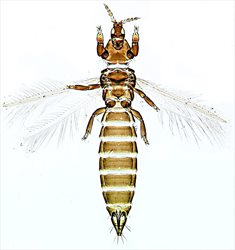
Female
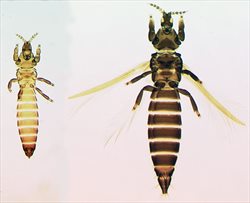
Male and female
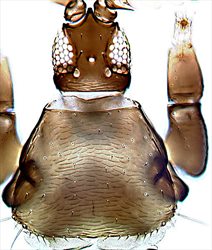
Head & pronotum
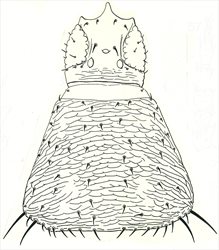
Head & pronotum

Antenna

Antenna
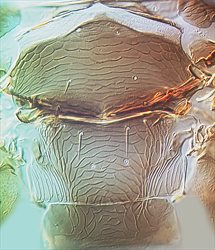
Meso & metanota
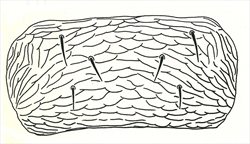
Male metanotum
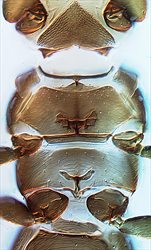
Thoracic sternites

Female tergites I-III

Female tergites VII-VIII
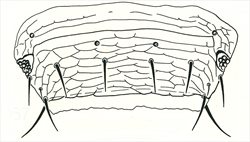
Female tergite VIII
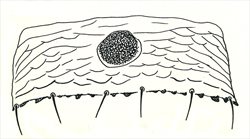
Male pore plate
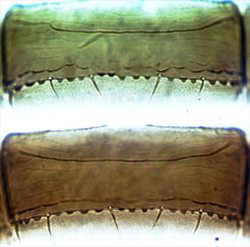
Sternites of female
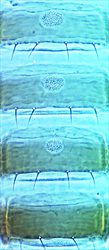
Male sternites

Fore wing
Female fully winged (rarely micropterous), but variable in size. Body, antennae and legs brown, tarsi paler, fore wings light brown. Antennae 8-segmented; segment II asymmetric with prolonged external margin bearing terminal seta-like sensorium; segments III–IV with sense cone simple and stout. Head small, prolonged in front of eyes with long preocellar area; 3 pairs of ocellar setae present, pair III anterolateral to fore ocellus; maxillary palps 3-segmented. Pronotum trapezoidal, 2 pairs of prominent posteroangular setae. Metanotum reticulate, sculpture forming arches around posterior midpoint; median setae not at anterior margin, smaller than lateral pair. Fore wings pointed; first vein distal half with 2 setae, second vein with 4 setae. Abdominal tergites with transverse sculpture lines medially; posterior margin with craspedum of weak lobes; ovipositor weak with faint teeth. Posterior margin of sternites with distinctive tubercles.
Male micropterous, with minute wing lobe; head without ocelli; sternites III–VII with small circular pore plate.
Currently there are 42 species worldwide placed in the genus Chirothrips. In contrast, zur Strassen (1960) treated the genus in a broad sense, with a key to 50 species, whereas Bhatti (1990b) placed several of the species into six new genera, and the generic classification was further reviewed by Nakahara & Foottit (2012). From Europe, zur Strassen (2003) recognised 14 species of Chirothrips, of which five have been taken in Britain. C. manicatus is very common in Britain, where it is the species of Chirothrips with antennal segment II produced outwards that is most likely to be encountered.
Each larva feeds and pupates within a single flower of its host plant, and these include Poaceae in several genera such as Alopecurus, Dactylis and Poa (Minaei & Mound, 2010).
Abundant throughout Britain and the island of Ireland, and across the Holarctic Region (Mound et al., 1976; O'Connor, 2008), but also introduced to Australia, New Zealand and Hawaii.
THRIPIDAE - THRIPINAE
Chirothrips manicatus (Haliday)
Thrips (Chirothrips) manicatus Haliday, 1836: 444
Thrips longipennis Burmeister, 1838: 413
Chirothrips antennatus Osborn, 1883: 154
Chirothrips manicata var. adusta Uzel, 1895: 81
Chirothrips manicata var. fusca Coesfeld, 1898: 474
Chirothrips similis Bagnall, 1909: 35
Chirothrips manicata Halid., forma aptera Schille, 1912: 4
Chirothrips albicornis Priesner, 1926: 140
Chirothrips ammophilae Bagnall, 1927: 564
Chirothrips takahashii Moulton, 1928: 289
Chirothrips manicatus f. microptera Maltbaek, 1929: 373
Chirothrips manicatus f. brachyptera Maltbaek, 1929: 373
Chirothrips productus Bagnall, 1932: 184
Chirothrips ambulans Bagnall, 1932: 185
Chirothrips laingi Bagnall, 1932: 185
Chirothrips manicatus f. testacea Hukkinen, 1935: 90
Chirothrips bagnalli Hood, 1938: 162
Chirothrips longisetis Priesner, 1949: 170
Bhatti JS (1990b) On some genera related to Chirothrips (Insecta: Terebrantia: Thripidae). Zoology (Journal of Pure and Applied Zoology) 2 (4): 193–200.
Minaei K & Mound LA (2010) Grass-flower thrips of the genus Chirothrips (Thysanoptera: Thripidae), with a key to species from Iran. Zootaxa 2411: 33–43.
Mound LA, Morison GD, Pitkin BR & Palmer JM (1976) Thysanoptera. Handbooks for the Identification of British Insects 1 (11): 1–79.
Nakahara S & Foottit RG (2012) Review of Chirothrips and related genera (Thysanoptera: Thripidae) of the Americas, with descriptions of one new genus and four new species. Zootaxa 3251: 1–29.
O’Connor JP (2008) A review of the Irish thrips (Thysanoptera). Irish Naturalists’ Journal 29: 20–24.
zur Strassen R (1960) Key to and catalogue of the known species of Chirothrips Haliday, 1836 (Thysanoptera: Thripidae). Journal of the Entomological Society of South Africa 23 (1): 144–176.
zur Strassen R (2003) Die terebranten Thysanopteren Europas und des Mittelmeer-Gebietes. Die Tierwelt Deutschlands 74: 1–271.